When our chicks and keet were just two days shy of six weeks old, we introduced them to our two older hens. Previously, the chicks were in a coop and outdoor pen while the free range older hens have fed from a Rugged Ranch Poultry Feeder attached to a pen post. This has allowed them to observe each other through the fence, but this was the first time that they finally met without borders.
The Introduction
I started by feeding the hens treats on opposite sides of the pen door. Then, later that morning, three of my grandsons and I let Olive into the chicks’ pen. The chicks were cautious around her, but she walked over to their feeder and ate like nothing was out of the ordinary… that is, until the young chicks tried to join her at the feeder. She gave a swift peck to any that came near and frightened them away.
To avoid injuries, we kept visits short and supervised but kept reintroducing them each day afterward. After a week of short visits, the older hens spent a full day and overnight with the chicks and guinea keets.
At night, they all settled on the top perch in the coop. It was a tight fit! I count them each night and had difficulty easily seeing around the two older hens. A closer look revealed black and white feathers below Olive’s tail feathers. She was sitting on Freckles! I removed Olive and placed her on the bottom perch where I found her the next morning. Meanwhile, Freckles shook herself off and found a more welcome spot on the top perch.

It became clear that I needed more perch space, so I redesigned the perches to fit side-to-side instead of end-to-end. Now there are six shorter perches instead of two longer perches. Now, they comfortably roost with two or three chickens per perch, but usually five of the young hens sit on the lowest perch closest to the exit. We decided to give the older hens more time to adjust to the new flock for a few weeks while they free ranged together. After that, I closed off the old coop and Olive and Rocky joined the flock in the new coop. I then reopened the old coop after a while because the old girls still wanted to use their old nesting boxes for egg laying.
Fun observation: The older hens had stopped laying until the young roosters were introduced to them.
The Guineas Grow Up
At four weeks old, the guinea keets matched the size of the average seven-week-old chick. Their Kalmbach Feeds Game Bird Breeder Plus Primalac Feed is full of protein! As babies, their head feather patterns were all unique. At five weeks old, the guineas started losing their head feathers, and I could no longer tell them apart. Under those adorable feathers, we began seeing light blue faces, and they developed a horn on the top of their heads. The horn reflects their new aggressive behavior to the chickens.
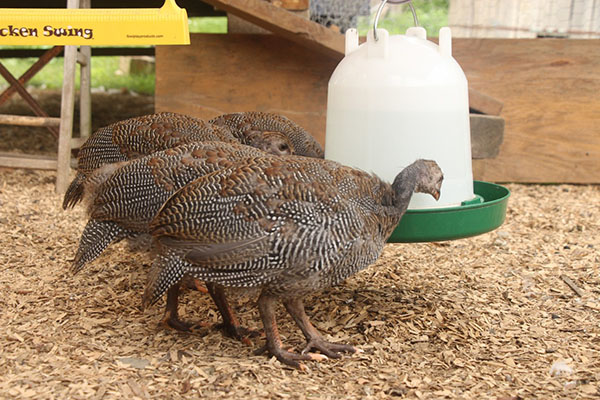
The old girls, Freckles (the one who bullied them when they were hatchlings), and the male Orpingtons aren’t bothered by them. However, Luna, Phoenix, Ophelia, Layla, and Rosey wish I didn’t get them.
Their loud voices and their cries of impending doom warn everyone something is amiss, giving the chicks time to take cover. The male guineas sound like a can of marbles being shaken and the one female makes a “come back!” cry. Being raised by Freckles, I have never had to worry about the guineas flying off or not coming back to the coop before nightfall.
Their dust bath is under the coop, which protects it from rain and snow, and they also have two run-in sheds for shelter in the upcoming winter weather.
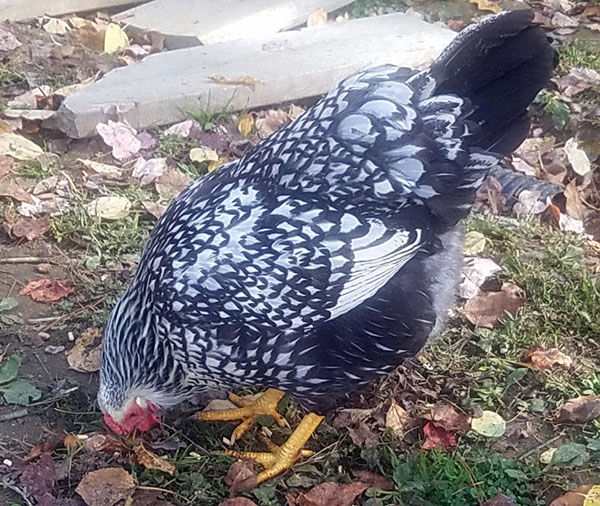
Let’s Hear It For the Boys
Beginning at eight weeks old, the Orpingtons could be identified by their waddles and combs. Layla’s waddle and comb are small, while the three cockerels have very pronounced waddles and combs. Also, at eight weeks old, Winter had already shown interest in the ladies, including the one female guinea, Winni.
Winter has become the flock protector, and he takes his job seriously – maybe too seriously. He likes to follow me around and make sure he gets snuggles and extra treats, pecking my feet if I don’t oblige. He enjoys a lift so he gets a high view of his flock. However, when something is amiss, like when the alpacas ate all the chicken food or whenever my grandkids are snuggling the hens, he can become a bit too aggressive, pecking and clawing until the matter is settled. The kids are getting used to his antics and are learning to deal with him, but at first I was afraid I would have to cull him. Some roosters can be real people peckers! He’s my special boy, and I know the flock needs him.
Chirple Gray knows he is the biggest and most handsome of the Orpingtons, but with Winter claiming the position of flock manager, he has decided on a life of solitude. He is happy to stay on the outside edge of the flock serving as rear guard. Cock-a-doodle-doo? Chirple practiced his first crow at 14 weeks! That initial crow sounded more like a mourning dove than a rooster. Shortly thereafter, all of the roosters found their voice. Some people are annoyed by rooster sounds. I love them!
Summer is lighter colored than the others, with a smaller comb and waddle. He is kind and gentle to the hens and has graciously fed and grazed side-by-side with them without shooing them away like the other rooster do. He never challenges Winter or Chirple Gray; for this reason, at 24-weeks of age, we typically find him outside the coop above the nesting boxes at sundown. I rebuilt the coop so he gets his own special entrance and shelf to sleep on. I enjoy tucking him in each night.
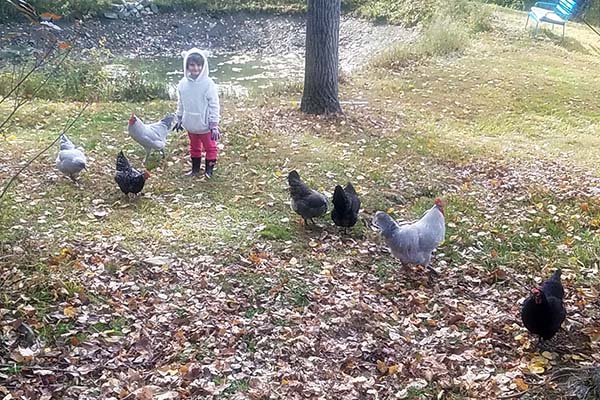
All of the male Orpingtons prefer to rest on the coop floor rather than perch, which meant they were directly under the hens. Part of rebuilding the coop also included the removal of several nesting boxes. I hoped they would tuck themselves into the nook rather than be rained on by droppings. Chirple understands, but Winter can’t watch the flock as well without being right under them. So he tends to be a dirty bird and the one I snuggle the most. I try to always remember the wet wipes so that I can keep him clean. So many accommodations need to be made for the boys!
The male guineas are proving to be more of a problem than a joy, although I haven’t had a tick on me since they began to free range. They enjoy picking on Winter just because Winni loves him. They also guard the food most of the day, preventing the hens from receiving the nutrition they need to lay eggs. Their territorial nature scares the hens from the entrance to the new coop nesting boxes.
The Chicken and The Egg
My older hens still prefer the old coop for nesting, and Luna and Rosie have figured out they can lay their eggs there. I haven’t found any of the other hens’ eggs in the nesting boxes. Although, today I found Ophelia in one of those old nesting boxes. If she succeeds, that leaves Layla, Phoenix, and Freckles yet to lay eggs, ones I can find anyway.
At 20 weeks old we found the first egg from the new hens. From the dark-reddish color we knew it was from Luna, the Midnight Majesty Maren. It was found under the bramble in the woods instead of in a nesting box. We will get lots of practice for Easter egg hunts with these free range hens!
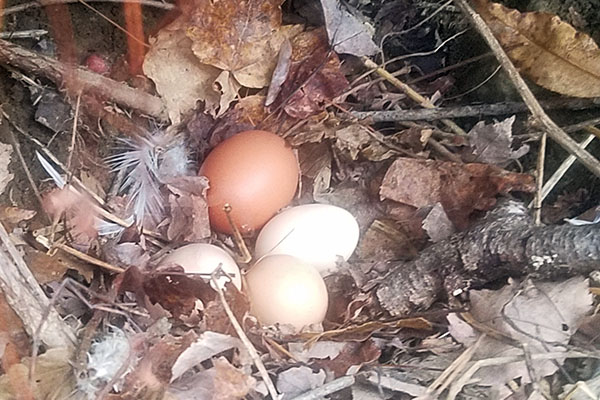
Hopefully, once the snow hits and the guineas are under control, the nesting boxes will be more attractive to the pullets. I have moved the food to the run-in shed, away from the alpacas and coops, which should help the hens relax and get them to start laying in one coop or the other. Their eggs are important to us and one of the many reasons that we love to raise chickens.
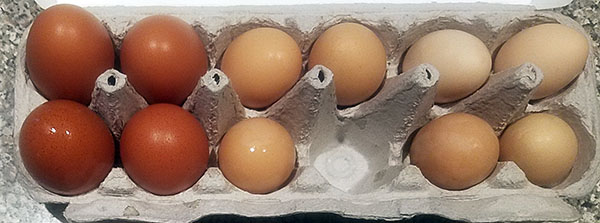
Home Sweet Home
Luckily, we haven’t had a problem with predators except for my new dog. She had to be trained that the birds were neither food nor toys. Early on, she chased one of the guineas that was learning to fly, and she caught and killed it. As long as I am keeping an eye on her she is fine, but those birds are so darn interesting! She is no longer able to be left outside alone. Take your pets into consideration when getting a backyard flock; their lives will change too.
Our yard is fenced which helps somewhat, although a bear could easily knock it down and a coyote could jump over it or dig under it without too much difficulty. We have three big dogs, and the alpacas and guineas sound an alarm that gets the dogs barking, so that helps too.
A strong coop is a must. The coops that I built are wood framed and double-walled with windows fenced over with wire mesh. I developed my plans after doing research and studying any coops I found at stores. The Amish Built Chicken Coops sold at The Cheshire Horse are substantial, and, although nothing is bear-proof, they would certainly slow a bear down so you would have time to scare them off.
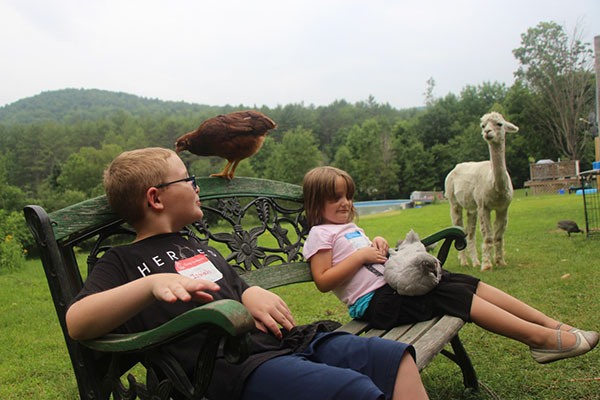
Keep your flock well nourished with quality feed, and always have fresh, clean water available. Protect them and grow with them, making changes as needed, and you will find them great pets with benefits that far outweigh their costs. Any time spent with your flock is time well spent.
Thank you for taking the time to go on this journey with me! I have enjoyed sharing the progress of my flock with you. I hope that my experience with my chicks has inspired you to add poultry birds to your family next spring.
